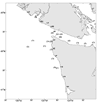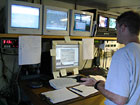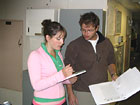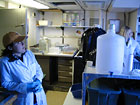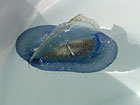

 | |||||||||||||||||||||||
|
|
Journals 2005/2006Denis Costello
July 23, 2005 Today marks the end of the normal grid survey. We will have surveyed the last of the LBC stations and then start our third survey, of the drifters and the paths that they have taken. This new survey will also allow for other science party members to take samples outside the normal grid area.
Since the sampling schedule is about to get lighter, I will be able to help Sean and Caroline with filtering their incubation experiment samples. I met with them to discuss the plan for sampling their experiments.
For the rest of the day, I read chlorophylls on the fluorometer and sampled when needed. Maureen and Julia were starting to acid-wash polycarbonate bottles for storage for the next cruise. The cleaning process consisted of washing bottles with 10% hydrochloric acid, followed by two Milli-Q rinses. Clean bottles are then filled with Milli-Q, leaving a small space for additional hydrochloric acid to be added before securing them for our arrival in Seattle.
After dinner, someone remarked how the water looked different. Upon closer inspection, it was determined that the surface was covered in Velella velella (By-the Wind Sailors), cnidarians that by utilizing a "sail", can be blown by the wind across the sea. Sean cast a bucket over the port side to snag one. While one board, we marveled at its color and design. Nature's careful engineered design of this animal allowed for it to travel this far out to see without expending any energy. We spent about 10 minutes looking at it before putting it back in the water.
After dinner, I came back down to the lab to help finish chlorophyll readings and assist with one more CTD sampling. I concluded my day by watching a movie and doing my laundry. |
||||||||||||||||||||||
